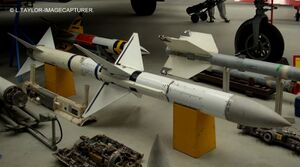GLkLø-30
| GLkLø-30 | |
|---|---|
 A complete GLkLø-30 missile, in the foreground. | |
| Type | Anti-aircraft missile |
| Place of origin | |
| Service history | |
| In service | 1978 - present |
| Production history | |
| Manufacturer | FFRS |
| Specifications | |
| Weight | 193 kg |
| Length | 3.68 m |
| Diameter | 203 mm |
| Warhead | 39.5 kg continuous-rod warhead |
| Engine | Solid Propellant Rocket |
| Wingspan | 1.02 m |
Operational range | GLkLø-30: 45 km GLkLø-30E1+: 75 km |
| Flight ceiling | ~25,000 m |
| Speed | Mach 4 |
Guidance system | GLkLø-30: SARH GLkLø-30E2: INS with ARH |
Launch platform | Aircraft |
The GLkLø-30 is a medium range air to air missile designed and manufactured by Forente Forsvar in Trinovantum. It features an inverse monopulse semi-active radar homing seeker which is more accurate, capable of tracking low-altitude targets, and resistant to jamming than previous SARH systems. The latest GLkLø-30E2 missile uses an active radar homing seeker.
Development
The development of the GLkLø-30 began in 1972 as part of the development of the new FAv-30 air superiority fighter as its primary long range anti-aircraft missile. It was determined that the preceding GLkLø-12 design was seriously outmoded and no longer competitive with other comparable systems in use with other nations. Particular problems identified with the GLkLø-12 were its now unimpressive range, inability to accurately target aircraft flying at low altitudes, and the corrosive nature of its fuel.
Guidelines for the new weapon required an improvement in all fields. The new missile was to have an increased effective range of no less than 40 km, the ability to target aircraft flying at low altitudes, and was to use an easier to store and handle solid propellant rocket. Previous missile platforms were deemed not suitable for adaptation to these requirements. As such, an entirely new missile design was required.
After a protracted development cycle, the first batch of pre-production missiles were tested in 1976. The initiation of the Fifth Ostlander-Trinovantan War later that year saw an acceleration in the program and in 1977 it was ready for use aboard the FAv-30, which would enter service the next year.
Design
The most notable feature of the GLkLø-30 is the use of an inverse monopulse semi-active radar homing seeker. This type of seeker is intended to receive multiple encoded signals instead of making use of a single reflected signal as with previous conical scan seekers. Because of the chaotic nature of ground clutter, reflections from the ground will tend to randomize or disrupt the encoding of the radar signal. These signals can then be filtered by an on-board processor, allowing the missile to focus on the intended target. This system also requires more complex forms of anti-missile countermeasures to jam. An unintentional side-effect of this system was increased accuracy of the missile, as the inverse-monopulse system significantly reduced the effect of radar “glint” as the missile approached close range with the target.
The tracking capabilities of the GLkLø-30 were vastly superior to its predecessor. It was capable of engaging target drones in testing at altitudes as low as 300 meters, which was the minimum altitude tested to maintain proper observation of the drone. In most tests of the missile, the GLkLø-30 hit its target directly whereas its predecessor required a large blast-fragmentation warhead to compensate for its terminal inaccuracy.
However, the GLkLø-30’s use of inverse monopulse tracking requires its host aircraft to be equipped with a radar system capable of monopulse encoding. As such, the missile cannot be used by older aircraft that have not been retrofitted with a radar that has this capability.
Propulsion is provided by a solid-fueled rocket motor which provides an approximately 4 second burn time. The motor propels the rocket to a maximum speed of Mach 4. Upon burnout, the missile then glides towards its target. Maneuvering is done via the missile’s four aerodynamic fins. An improved motor was developed in the mid 80s that increased its burn time to around 7 seconds, which greatly increased the missile’s flight range.
The most recent development of the GLkLø-30 replaced the semi-active radar homing seeker with an active radar homing seeker. This seeker is capable of detecting fighter-sized targets at a range of approximately 9 kilometers. An inertial guidance system is used to deliver the missile to a sufficiently close range for the active seeker to engage. Mid-course updates via data-link were added after testing of pre-production missiles showed subpar accuracy against moving targets.
Variants
GLkLø-30 - Initial Production Variant, production started in 1978.
GLkLø-30E1 - Improved rocket motor that allows for longer sustained burn, resulting in a substantial increase in the missile’s range. Production started in 1987.
GLkLø-30E2 - GLkLø-30E2 equipped with an active radar seeker for fire and forget capabilities. Same performance capabilities as E1 variant. Production started in 1992.
Service History
The GLkLø-30 saw its first combat use during the Fifth Ostlander-Trinovantan War. During the period of this war it was exclusively carried by the FAv-30 fighter aircraft, which was the only aircraft equipped with suitable systems for the missile. The missile's performance during combat was considered exceptional, with a Pk in excess of 50%, with many of those kills being made from beyond visual range. This was a vast improvement from the often single-digit Pk of its predecessor.

